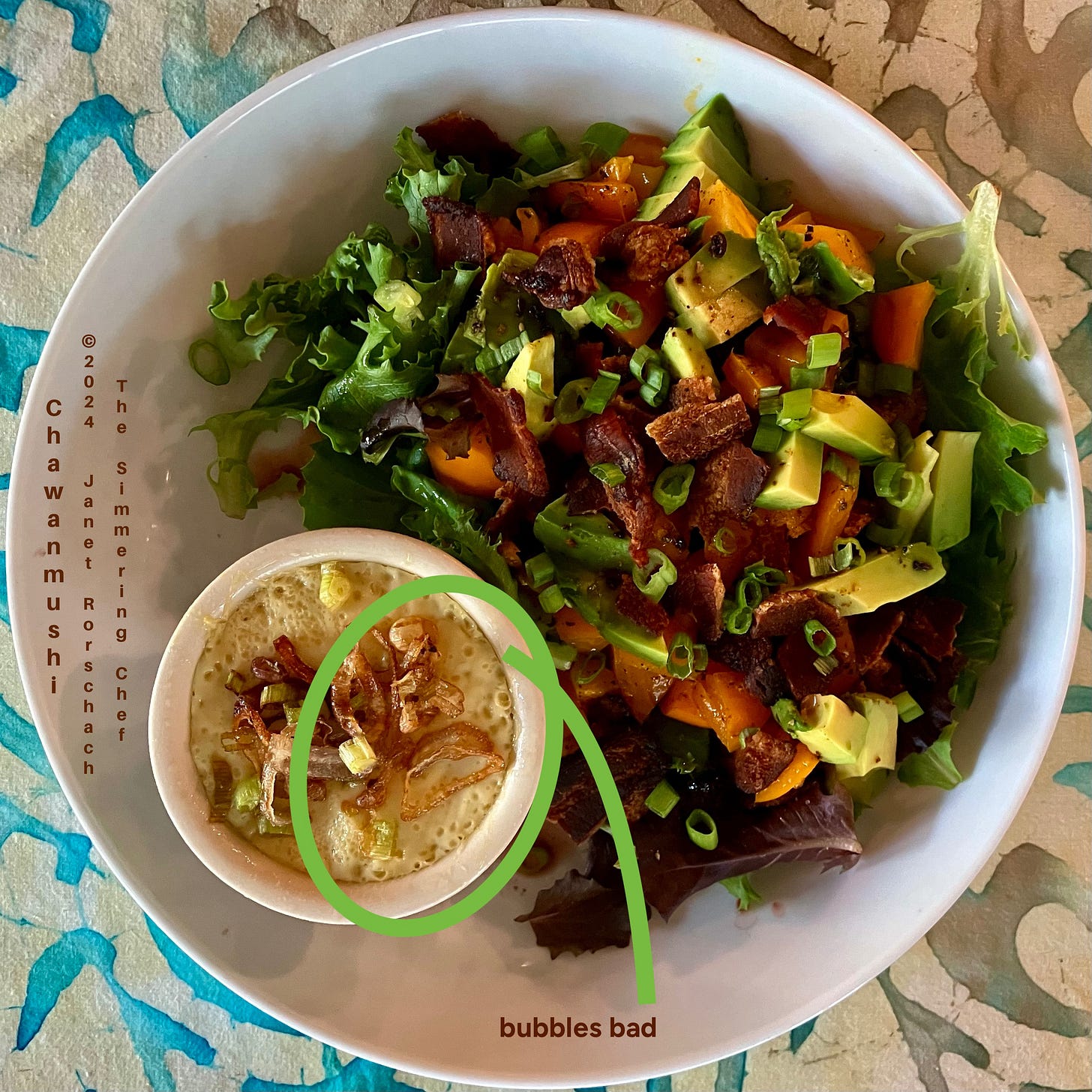This wasn’t supposed to work. My CIA* training told me that, for an egg custard to set, you shouldn’t mix more than 3/4 cup of liquid to 1 egg; even that ratio would make a weak custard. In his excellent book RATIO, Michael Ruhlman suggests that when making custard, you should use 2 whole eggs for every cup of milk, noting that 1 egg will barely thicken when mixed with ¾ cup of milk. Traditionally, the ratio is 2 eggs to 1 cup of milk, which gives your custard some density.
Who in their right mind would tempt fate by adding more liquid than those proper ratios?
The Japanese! They tempt and succeed! Chawanmushi** is the most enlightening way to make eggs I’ve ever come across. I imagined a watering, drippy concoction. Instead, I bit into a delicious version of a silky, creamy, umami, edible paradise.
The ratio for chawanmushi is this: 1:3, but not a traditional 1:3 of an egg to a cup of liquid. A scale is your best friend here. If my eggs weigh 150 grams, I gently whisk in 450 grams (ml) of liquid into them.
I had to practice making this several times because there are expectations concerning how it should look and its expected texture. In the photo above, you’ll notice all the little holes. Those are su—meaning bad. They signify that I cooked the custard too hard over too high heat, making its texture rubbery. Bad, Janet, but with practice and patience, I learned. This is cooked over such a low temperature that the custard’s texture is very soft and silky. It was like eating a dream.
Chawanmushi is a delicate egg dish loaded with lots of umami and balanced with a touch of sweetness. I found this very satisfying to eat. You’ll be happier if you dig into this with a small spoon or embrace how the Japanese eat it with a small wooden spoon. The recipe fills 8 to 9 four-ounce ramekins and makes a light lunch when served with a lightly dressed salad.
CHAWANMUSHI
CUSTARD INGREDIENTS
Toasted sesame oil to brush the ramekins, or if you really like these, consider upgrading your game and buying a chawanmushi pot.
150 grams whole eggs, without the shell (Usually, that’s 3 eggs.)
450 grams of cooled housemade dashi stock or Ocean’s Halo Miso Broth
1 teaspoon mirin
1 teaspoon tamari, soy sauce, or usukuchi soy sauce (a light-colored soy sauce)
½ teaspoon kosher salt
CUSTARD GARNISH
I like to keep my garnish simple, but you can add whatever you want. Consider chicken tenders sliced very thinly or sliced raw scallops and shrimp. Enoki mushrooms are lovely in this, too.
1 teaspoon avocado oil
2 green onion stalks, cleaned, trimmed, and the white part sliced thinly. Save the green stalks for garnish.
Pinch of kosher or sea salt
CUSTARD TOPPERS
Fried shallots
Mirco tomatoes
The green part of green onions, finely chopped
METHOD
Quickly sauté the green onions in the avocado oil until they begin to brown. Remove from the heat and season with a bit of salt. Reserve until cool.
Brush each ramekin with a light coating of toasted sesame oil.
If adding chicken or seafood, layer the bottom of the ramekin with your chosen ingredients. Do the same if you are using mushrooms or green onions.
Set up a steamer pan or steamer basket with water and bring the pot to a very gentle simmer.
In a bowl, stir together the dashi stock, mirin, tamari, and kosher salt.
In another bowl, whisk the eggs together with a fork. Do not whisk vigorously. You don’t want the whipped eggs to be foamy.
Measure the eggs on the scale and multiply that measurement by 3 to get the liquid amount. For example, 100 grams of egg means you will use 300 grams of liquid. (Refrigerate any leftover liquid and use it for the next batch.)
Gently whisk the eggs and measured liquid, then strain to remove any egg strands.
Ladle the egg mixture into your ramekins. If you have leftover egg mixture, refrigerate it and use it the next day.
Carefully wrap the ramekins with some parchment paper, leaving a gap so that steam does not build up and drip onto the eggs. (See photo above.)
Carefully place the ramekins into your gently simmering steamer.
Cover the pot or steamer with a lid, and cook for 40 minutes or until a skewer is inserted into the center of the egg mixture and the liquid bubbling up from the hole looks clear.
Once cooked, carefully remove the ramekins from the steamer and remove the parchment paper. You might need a pair of tongs for this.
Garnish with fried shallots, chopped green onions, and/or cooked seafood.
This is best served warm and with a lightly dressed salad.
TECHNICAL NOTES
Remember, math is your friend here. Weigh the cracked eggs without the shell, then multiply by three (3) to get the correct liquid measurement.
Always strain the egg mixture. Straining removes any strands, helping the texture maintain its silkiness.
Remember to only partially cover the egg dish.
Keep the pan at a very gentle simmer.
*Culinary Institute of America
**The literal translation is “teacup steamed.”







This sounds so delicious! I’m going out today to get the ingredients to make dashi.
A well-executed chawanmushi is heaven in a cup 😋. We also do a more Chinese style egg custard with just pork mince, using a 1-to-2 egg-to-liquid ratio (also by weight), that's steamed in a shallow bowl. Just before serving, we sprinkle it with scallion slivers and ladle sizzling oil over the top.